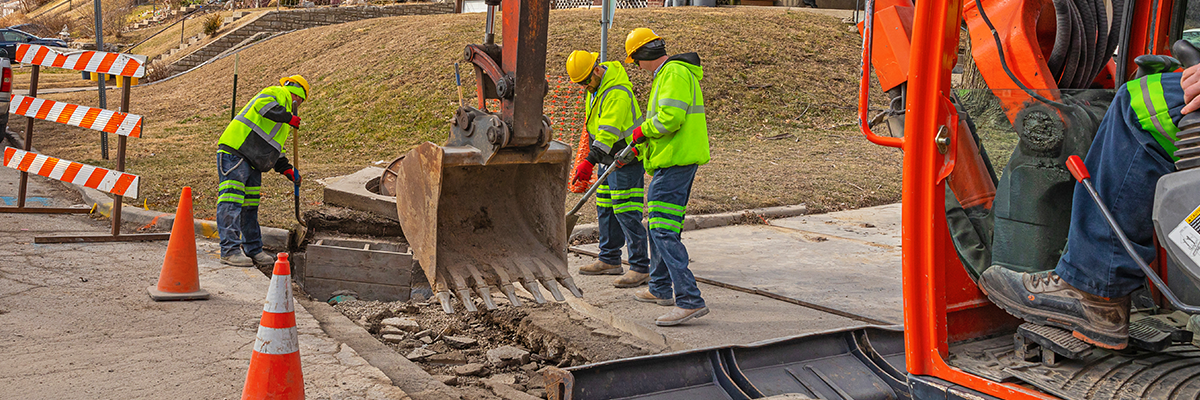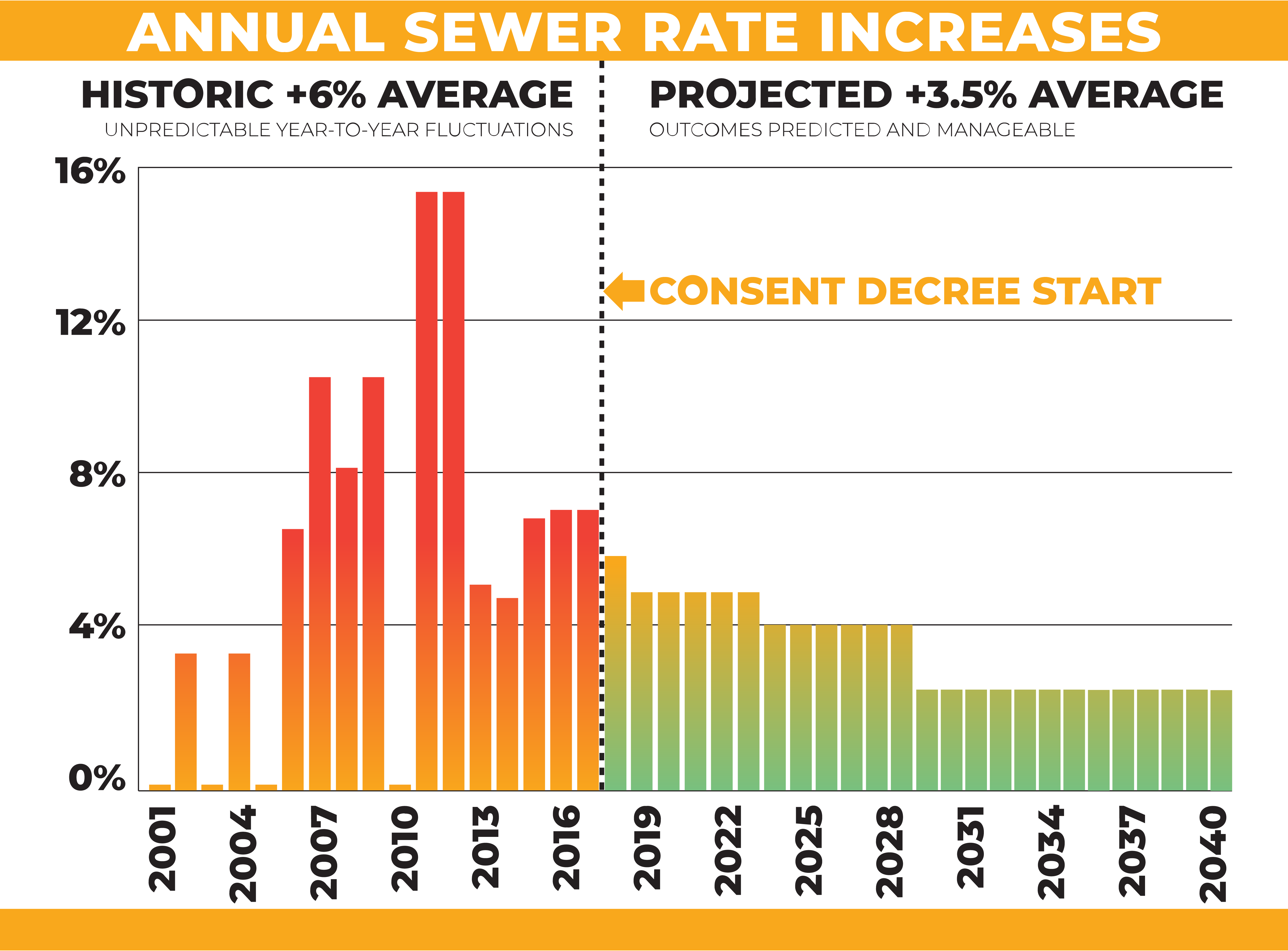Sewer Investment Program
 Like many communities across the nation, the Unified Government (UG) has an aging sewer system that requires continuous maintenance. As our community grows, that adds more flow to the system. If this system is not properly maintained, multiple issues could be created or worsen. Through an agreement with the Environmental Protection Agency (EPA), the UG is following through with the Sewer Investment Program, which provides a framework of projects for the Public Works' Environmental Services division to work under to repair and replace older portions of the system and construct new pipelines and infrastructure where needed.
Like many communities across the nation, the Unified Government (UG) has an aging sewer system that requires continuous maintenance. As our community grows, that adds more flow to the system. If this system is not properly maintained, multiple issues could be created or worsen. Through an agreement with the Environmental Protection Agency (EPA), the UG is following through with the Sewer Investment Program, which provides a framework of projects for the Public Works' Environmental Services division to work under to repair and replace older portions of the system and construct new pipelines and infrastructure where needed.
The plan spans 25 years and requires a total investment of approximately $900 million. This investment will provide you with more efficient, reliable, and sustainable sewer infrastructure, meet Clean Water Act regulatory requirements, and, most importantly, meet the needs of our community at a reasonable cost to ratepayers.
Projects
There are several projects large and small, that are happening throughout our community as part of this plan.
Jersey Creek Sewer Separation
Location: North and South of Jersey Creek, east of Wyandotte County High School. Multiple Projects will be conducted in this area to separate the combined sewers in the Jersey Creek watershed, significantly reducing combined sewer overflows. The Jersey Creek Sewer Separation is the first phase of much larger corridor improvements. Stay tuned for more information about how you can weigh in on what improvements you would like to see. More info is coming soon!
System-Wide Supervisory Control and Data Acquisition (SCADA) Improvements
Happening across Wyandotte County, this effort includes upgrades to pump stations remote monitoring hardware and software to improve operations and reduce maintenance costs. More info is coming soon!
Other Projects
Kaw Point Wastewater Treatment Plant Biosolids Digestion Improvements
More information is coming soon!
Wolcott Wastewater Treatment Plant
 Public Works began planning for the roughly $54-million investment in 2015 to accommodate future population growth in the Piper area and safeguard the environment by reducing overflows caused by heavy rainfall. The plant became operational in late 2021.
Public Works began planning for the roughly $54-million investment in 2015 to accommodate future population growth in the Piper area and safeguard the environment by reducing overflows caused by heavy rainfall. The plant became operational in late 2021.
The investment contains three distinct parts working together: the Wolcott Treatment Facility, which cleans wastewater; the Lower Conner Creek Interceptor (pictured above), which spans nearly 4 miles and carries wastewater away from homes and businesses; and Pump Station 70, which helps move wastewater up hills:
- Wolcott Wastewater Treatment Facility: The treatment facility cleans wastewater before returning it safely to the environment.
- Lower Conner Creek Interceptor: The interceptor spans nearly 4 miles and carries wastewater away from homes and businesses.
- Pump Station 70: The pump station helps move the wastewater up hills and to the treatment facility.
The plant processes daily flows of 2 million gallons and was designed to readily accommodate 4 million gallons within the next 10 years. Ultimately, the plant’s capacity is expected to handle average daily flows of 18 million gallons or roughly 64,300 rooftops. This treatment plant is the 5th of its kind in the nation as uses new technology, aerobic granular sludge, which eliminates many of the traditional wastewater treatment steps, reduces operational complexity, and decreases maintenance needs while keeping the community and the environment safe from harmful toxins.
Sewer Overflows
On May 20, 2020, the UG entered into an agreement, also known as a consent decree, with the Department of Justice and EPA to improve our compliance with the Clean Water Act. The agreement requires the UG to further reduce sewer overflows over a period of 25 years. Without a consent decree, the UG would have to pay large fines and penalties and still be responsible for repairing and upgrading the sewer system to reduce sewer overflows. Sewer overflows are a release of sewage (wastewater) into the environment.
Sewer overflows typically occur during rain events where our stormwater and sewer infrastructure is combined. As you see below, the rain can lead to an influx of stormwater in the system, leading to overflows into our waterways. That overflow sometimes contains untreated wastewater. This untreated wastewater is directed only to Water Pollution Control treatment plants in separate systems.
 (PNG, 349KB)
(PNG, 349KB)
Learn More About Environmental Services
Frequently Asked Questions
What is a Consent Decree?
On May 20, 2020, the UG entered into an agreement, also known as a consent decree, with the DOJ and EPA to improve our compliance with the Clean Water Act. The agreement requires the UG to further reduce sewer overflows over a period of 25 years. Without a consent decree, the UG would have to pay large fines and penalties and still be responsible for repairing and upgrading the sewer system to reduce sewer overflows. Sewer overflows are a release of sewage (wastewater) into the environment.
Who Approved the Consent Decree?
Commissioners and the Mayor of the UG approved the consent decree after more than 10 years of negotiations. While negotiations with the DOJ and EPA were happening, UG staff monitored and studied the sewer system, constructed numerous system improvement projects, engaged with stakeholders, and made operational improvements. This hard work and determination created a custom solution better tailored to the UG and our ratepayers.
Why Does the Sewer System Need Repairs?
Like many communities nationwide, the UG has an aging sewer system that requires continuous maintenance. As our community grows, that adds more flow to the system. If this system is not properly maintained, multiple issues could be created or worsen. Those issues include sinkholes in our streets, stormwater seeping into our sewer system, and sewage overflowing into our creeks and streams or backing up into homes.
How Will We Fix Our Sewer System?
Part of the consent decree includes a Sewer Investment Plan, which provides a framework for our efforts to repair and replace old pipes and equipment and construct new sewer system infrastructure.
The plan spans 25 years and requires an investment of approximately $900 million. This investment will provide you with more efficient, reliable, and sustainable sewer infrastructure, meet Clean Water Act regulatory requirements, and, most importantly, meet the needs of our community at a reasonable cost to ratepayers.
How Much Will the Sewer Investment Plan Cost?
Over the next 25 years, we are committed to investing approximately $900 million in our sewer and stormwater systems to provide you with more efficient, reliable, and sustainable sewer infrastructure and meet Clean Water Act regulatory requirements.
In 2020, the UG adopted a 25-year Sewer Investment Program as part of a Consent Decree agreement between the UG, DOJ, and EPA. The Sewer Investment Program supports the Public Works Department’s ongoing efforts to address sewer overflows and basement backups in our community.
The investment plan establishes consistent and manageable sewer rates over the next 25 years, providing predictable funding for future investments through steady marginal rate increases projected to be at or below five percent each year. For comparison, annual sewer rate increases over the previous 20 years averaged six percent, reaching 15 percent in 2011 and 2012.
How are we paying for the sewer investment plan?
The Sewer Investment Plan will be implemented over 25 years. This timeline outlined in the consent decree allows us to fund the plan with manageable and predictable sewer rate increases.
Since 2001, sewer rates have increased an average of 6% yearly. During the implementation of the Sewer Investment Plan, sewer rate increases are anticipated to average 3.5% annually.
How much will this cost me? Will my sewer bill go up?
Beginning in January 2021, you will notice a slight increase in the “water pollution abatement” (sewer) charge on your BPU bill. For the average household, this increase will amount to approximately $2.30 per month or about $28 per year.
How is this related to the stormwater fee?
This is unrelated to your stormwater management charge on your BPU bill. For information about the stormwater user fee, see Stormwater.
Will this create jobs, and how can I apply?
The Sewer Investment Plan will utilize contractors to perform much of the construction, engineering, and other supporting positions.
Contractors are encouraged to hire locally and use local vendors throughout the implementation of this plan. For more information about jobs in Wyandotte County visit workforcepartnership.com or call (913) 279-2600. For more information about jobs with the UG, see Careers.
Will the pipe connecting my house/business to the public sewer be replaced/repaired?
No. As a homeowner, you own and are responsible for the interior plumbing and exterior sewer/septic service line from your house to the public sewer main connection. These pipes will remain your responsibility for any necessary maintenance and repair. The UG partners with HomeServe USA to offer home repair plans to protect you from the expense and inconvenience of sewer line emergencies. HomeServe is an independent company, separate from the BPU and the UG.
Who do I contact with questions about the sewer investment plan?
For more information about the Sewer Investment Plan or your sewer bill, call Environmental Services at (913) 573-1300.
Regulatory Information
The Clean Water Act 1972 regulates combined and separate sewer systems. When it rains, the combined sewer system receives wastewater and an influx of stormwater. With an abundance of stormwater entering the sewer system at once, it can reach its capacity, overflow, and release a mixture of stormwater and wastewater into our environment. A certain amount of combined sewer overflows is allowed, with limitations on their occurrence and frequency. However, we are working to drastically reduce these overflows through our Sewer Investment Program.